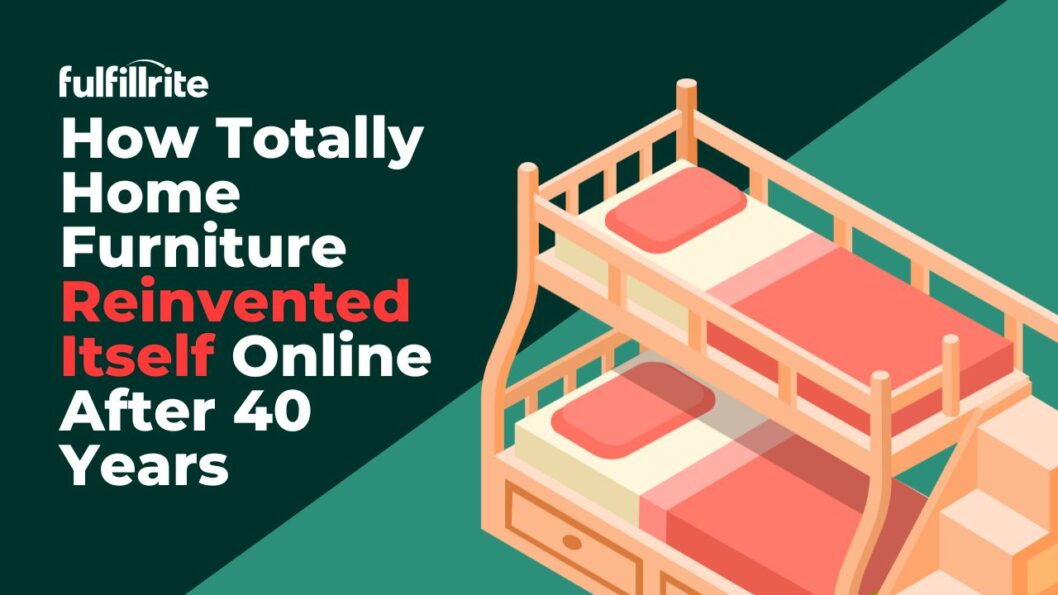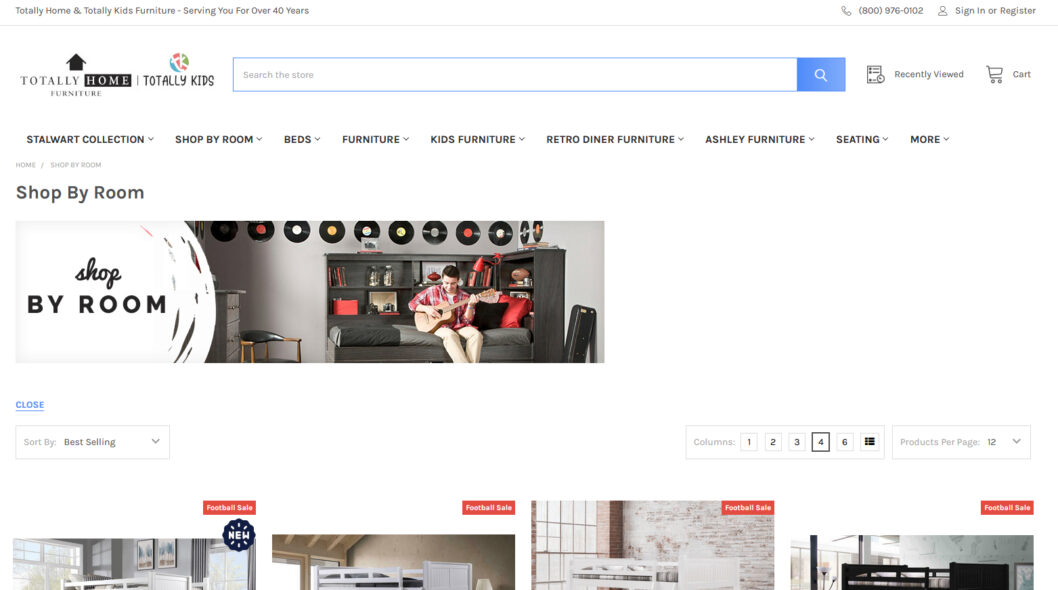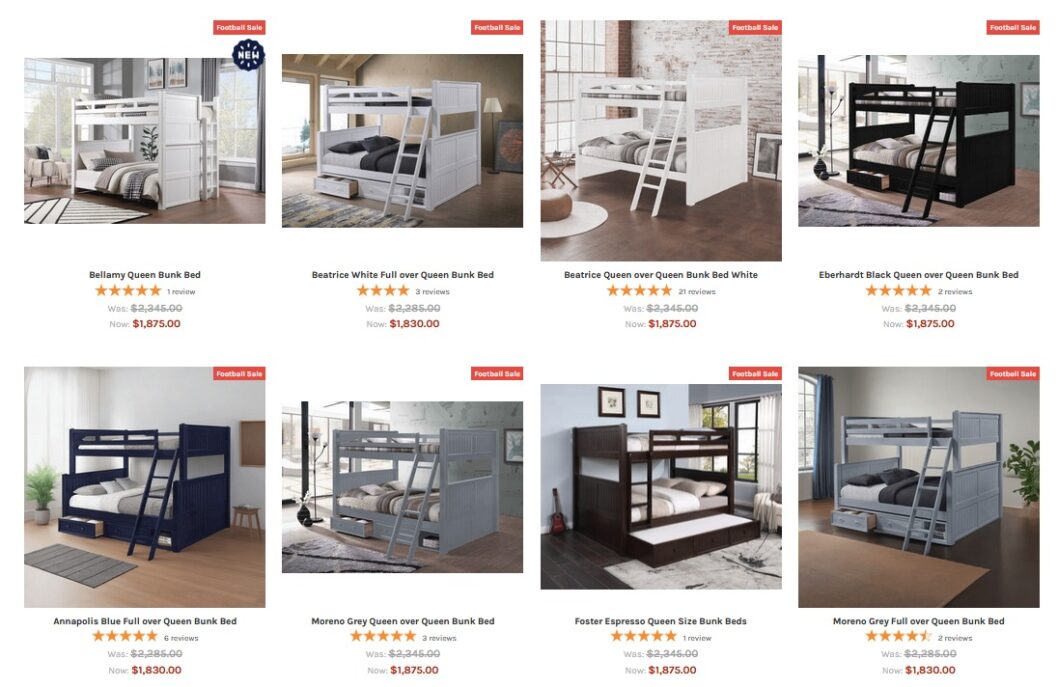Imagine taking over a 40-year-old furniture business in 2020.
Not 2019. Not 2021. Right in the middle of the worst retail disruption in modern history.
That’s exactly what Richie David did when he became president of Totally Home and Totally Kids Furniture.
When Richie started in his new role, the brick-and-mortar location was already closed. The business was operating online from an office. And as you might expect for a business operating during the pandemic, there were all kinds of supply chain problems. That included massive shipping delays, port congestion, factory shutdowns, raw material shortages, and costs that skyrocketed overnight.
But with enormous challenges came a slew of new opportunities.
“It was a time of uncertainty everywhere in the world,” Richie says. “Everyone was home and fortunately wanted to spend on their home. So while the business was good, the challenges were even bigger.”
Today, Totally Home Furniture operates entirely online, serving everyone from parents furnishing nurseries to Airbnb hosts outfitting vacation properties. They’ve built a business around personal shoppers, furniture expertise, and quality products. And they compete directly with giants like Wayfair and Amazon by offering something those platforms can’t: real human guidance from people who know furniture.
This is the story of how a family-owned furniture business with 40+ years of history navigated a complete digital transformation during the worst possible time—and came out stronger.
Inheriting a Mature Brand During a Pandemic
Katherine Howes founded Totally Kids Furniture over 40 years ago with a clear mission: bring safe, fun, age-appropriate furniture options to families.
Throughout her 30+ years of interior design experience, she’d realized there was a serious lack of children’s furniture options on the market. She made it her mission to offer the largest selection of kids furniture on the planet, from their first big bed to their college loft.
By 2020, “she was ready to retire and travel the world full-time,” Richie explains.
Even if you take the pandemic out of the question, the transition from being founder-led to new leadership could have been rocky, but Richie had a clear vision for how to honor the company’s legacy while bringing it into the modern digital age.
“The best way to honor the company’s legacy [was] to continue our personal shoppers, excellent customer service, and bringing high quality furniture at the best prices,” he says. And as part of that, he “wanted to get the business up to speed with the online world, with an updated website and reviews added.”
Richie brought over 22 years of experience in digital marketing to the role. That helped him to “understand what buyers are looking for, questions they have, and how to build that trust.” And it’s this background that would prove essential for what came next.
The retail portion of the business had already closed before Richie stepped in. They were just operating the online part of the business from the office.
In a twist that was surprising at the time, demand was actually strong. With the benefit of hindsight, it’s only too obvious why: people stuck at home wanted to improve their living spaces.
And it’s here that Richie saw an opportunity.
People needed furniture. They were shopping online more than ever. And Totally Home had 40 years of supplier relationships, product expertise, and customer trust to build on.
So the question became: how do we push people to our website?
Working With A Quirky Domain Name
One of the first things you notice about Totally Home Furniture is the domain name: thebeanbagstore.com. Not totallyhomefurniture.com or shoptotallykids.com.
This URL suggests they sell bean bags. But the reality is that they offer everything from triple bunk beds to retro dining sets to queen loft beds.
Managing three different domains—thebeanbagstore.com, shoptotallykids.com, and totallyhomefurniture.com—seems like it would directly contradict SEO best practices and create brand identity challenges as well. But Richie has a pragmatic approach to the situation.
“Thebeanbagstore.com is the original domain and many know us from that so we decided to keep it.”
And sure, it’s not the most intuitive brand architecture. But it’s grounded in practical business reality. They have brand equity in that original domain. There’s link juice and domain authority tied to that domain. Customers know them by it. Changing it would mean starting from scratch with SEO, losing traffic, and confusing longtime customers.
So instead of forcing a rebrand, they embraced the complexity. The three domains all redirect to thebeanbagstore.com, which now serves as the primary URL for a company that sells far more than bean bags.
Going Beyond Kids Furniture
The company still claims “the largest selection of kids furniture on the planet”—and they can back it up.
But of course, for a company that’s been around a while, it’s not a small task to expand from kids-only to “Totally Home”. Going from selling kids furniture alone to furniture for every life stage is, by definition, a form of brand dilution.
And, indeed, how do you sell cribs, retro kitchen sets, and adult bunk beds without losing your identity?
Richie’s answer is simple: “We stick with quality suppliers, so you can trust what you are buying online.”
Those relationships, built over four decades, are the foundation of everything. They’re not manufacturing furniture themselves. They’re curating it from trusted suppliers and offering it through a single, easy-to-navigate online store.
In short, their product offerings changed, but their basic selling proposition didn’t. They’re careful curators and quality is the through-line whether you’re buying a toddler bed or outfitting an entire vacation rental.
Breaking Into the Vacation Rental Market
One of the most interesting pivots Totally Home made was by breaking into the Airbnb and Vrbo markets. Vacation rental owners are now a significant customer segment—and it wasn’t by accident.
“We offer beds that work for these types of properties trying to maximize occupancy,” Richie explains.
Think about what vacation rental owners need. They’re not furnishing a single-family home where one kid sleeps in each bedroom. They need to maximize sleep capacity to justify nightly rates.
For a lot of rental owners, that means adding bunk beds. But you can’t just put in any bunk beds an expect the five-star reviews to keep rolling in. They need specialty configurations that most mainstream furniture stores don’t carry.
Twin-over-queen. Queen-over-queen. Triple bunks. Queen loft beds with space underneath for a desk or seating area.
This is not what people seek out in their primary residences. But they are absolutely sensible if you need a configuration that sleeps 6-8 people in a 3-bedroom property.
The vacation rental market is enormous and growing. It reached $99.6 billion in 2023 and is projected to grow at 3.7% annually through 2032. Short-term rental platforms like Airbnb and Vrbo have fundamentally changed how people travel—and created a massive demand for furniture that works in those properties.
Vacation rental furniture also needs to be durable. It needs to withstand constant turnover and heavy use from guests who won’t treat it like their own. It needs to be easy to clean. And it needs to maximize space and sleep capacity to justify the investment.
Totally Home’s specialty bed configurations fit those needs perfectly. And their long-standing supplier relationships mean they can offer products you won’t find at Wayfair or on Amazon.
But specialty products are only half the equation. The other half is logistics.
The Logistics of Selling Furniture Online
There’s no way around it: the logistics of shipping furniture is a bear. There are the high shipping costs, complicated returns, assembly requirements, and the risk of damage in transit. These challenges get even more complicated when you’re shipping large items like bunk beds and dining sets across the country.
“We partner with furniture specific shippers that can offer white glove services,” Richie explains. “We work with several shipping companies to find the best option for shipping based on time and cost.”
White glove service means the carrier doesn’t just drop a box on the porch. They bring it inside, unpack it, assemble it, and remove all the packaging materials. For a vacation rental owner furnishing multiple properties, that service is invaluable.
What’s notable here is that Richie gives this part of the business the attention that it’s owed. Shipping quality furniture only to have it show up damaged is not going to be good for anyone involved—buyer or seller.
Competing With Giants
Let’s be honest: competing with Wayfair, Amazon, and big-box retailers sounds nearly impossible. They have massive marketing budgets, advanced logistics networks, and name recognition that a family-owned furniture store could never match.
So how does Totally Home compete?
“We offer personal shoppers,” Richie says. “Have a question you can get us on chat, email, phone and ask questions from our furniture experts that really know the products.”
This is the key differentiator. And it’s a smart one, too, because it’s utterly impossible to out-compete Amazon and Wayfair on price.
When you shop on Amazon or Wayfair, you’re browsing listings and reading reviews. When you shop with Totally Home, you can talk to a real person who knows furniture—not just SKU numbers and shipping times, but actual product knowledge about construction, materials, sizing, and whether a specific bed will work for your space.
That human expertise matters most for their diverse customer segments. Parents furnishing nurseries have questions about safety standards and which cribs convert to toddler beds. Vacation rental hosts need to know if a triple bunk will fit in a room with 8-foot ceilings. College students want to know if a loft bed will work in a tiny dorm room.
Personal shoppers can answer all of those questions in real-time, via phone, chat, or email. Giants like Amazon and Wayfair simply can’t offer that level of personalized service at scale.
But here’s the interesting part: Richie doesn’t try to market separately to each segment. “Quality products will sell themselves,” he says, “you just need to get them in front of the right audience.”
The strategy is to let product quality and customer reviews drive the business.
“We love reviews, want to know how customers use the furniture, how it’s standing up to everyday use and if they met their need,” Richie explains. “Then we use that to promote those products and ones from manufacturers like that since we know the quality is real.”
They use Shopper Approved to collect verified reviews from actual customers. The platform is an official Google Review partner and ensures authenticity—which means customers can count on the fact they’re not reading fake reviews or cherry-picked feedback.
It’s a feedback loop that keeps quality high and helps Totally Furniture make sure they are offering products that work for their customers—not just what looks good on a product page.
SEO for an Established Business
Richie’s 22 years of digital marketing experience have been essential to Totally Home’s success online. But even with that expertise, he’s learned hard lessons about what it takes to compete in furniture eCommerce.
The biggest “learning the hard way” moment? “SEO is an ongoing process, if you aren’t working the others will pass you up.”
It’s a lesson many eCommerce businesses learn too late. They invest in SEO once—optimize their product pages, write some content, build some links—and then assume they’re done. But SEO doesn’t work that way, especially in competitive categories like furniture.
Competitors are constantly improving their sites, adding content, earning links, and optimizing for new keywords. If you’re not actively working on SEO, you’re falling behind. In furniture, where customers do extensive research before buying and the sales cycle can take weeks or months, SEO is critical for being discovered at the right moment.
Making Changes without Breaking Anything
Richie understands the importance of making changes thoughtfully in an established business. When he took over from Katherine, he didn’t rush to overhaul everything.
“We make changes slowly,” he explains. “You don’t always understand why decisions were made so we try to not rush to change things. Let everything run as is and make changes only after you understand why the previous decision was made.”
That’s wisdom that only comes from experience. It’s tempting to look at a 40-year-old business and assume everything is outdated and needs to be modernized immediately.
But often there’s logic behind decisions that seems invisible at first. A supplier relationship that looks inefficient might be providing crucial backup inventory. A product category that seems random might serve a loyal customer segment.
By making changes slowly and understanding the “why” behind existing decisions, Richie avoided disrupting what was already working while still modernizing the parts that needed it—like the website, review systems, and digital marketing strategy.
Looking ahead, Richie has clear goals for expansion. “We want to do more dining sets and couches.”
It’s a logical next step. They’ve mastered specialty beds and kids furniture. They serve vacation rental owners who need complete furnishing solutions, not just beds. Expanding into dining sets and living room furniture positions them as a one-stop shop for entire homes and properties—not just bedrooms.
But true to form, they’ll approach that expansion thoughtfully, with an eye toward quality suppliers and customer feedback.
Final Thoughts
After more than two decades in digital marketing and several years leading Totally Home through its online transformation, Richie has strong opinions about what works in furniture eCommerce.
The challenge of building trust online is especially acute in furniture. People can’t touch the product, sit on it, or see the color in person. They’re spending hundreds or thousands of dollars based on photos, descriptions, and reviews. That’s a big leap of faith.
Richie’s advantage is understanding “what buyers are looking for, questions they have, and how to build that trust.”
His answer is threefold: personal shoppers who can answer questions in real-time, verified customer reviews that show how products perform in actual use, and transparency about suppliers and quality standards.
He combines this with his philosophy of making changes slowly in an established business as well. Counterintuitive though it may seem in a digital world that prizes “move fast and break things,” it’s a smart approach to stewarding a well-established business.
Slow and thoughtful beats reckless and fast.
After 40 years, Totally Home Furniture is still growing, still adapting, and still putting customer service and quality first. They’ve survived the transition from brick-and-mortar to eCommerce, weathered a pandemic that decimated retail, and found new markets like vacation rentals that didn’t exist when Katherine first opened the doors.
That’s not just survival. That’s evolution.
You can explore their full collection at thebeanbagstore.com or connect with them on Facebook.
Key Takeaways
Did you read this piece looking for tips on how to grow your own business? Here are some things that stood out to me.
Respect the past, but don’t be afraid to modernize.
Richie kept what worked—personal shoppers, quality focus, supplier relationships—while updating the website and review systems for the digital age. Respecting the past doesn’t mean being stuck in it.
SEO is never “done.”
If you’re not actively working on it, competitors will pass you up. It’s an ongoing process, not a one-time project. This is especially critical for high-consideration purchases like furniture where customers research extensively before buying.
Make changes slowly in an established business.
Understand why previous decisions were made before changing them. There’s often wisdom in what seems outdated at first glance. Let everything run as is and only make changes after you understand the logic behind existing systems.
Specialized expertise beats scale.
Personal shoppers who know furniture can compete with Amazon and Wayfair by offering something giants can’t replicate: real human guidance from experts who understand products, not just SKU numbers.
Find your niche within the niche.
Vacation rental owners need different furniture than families with young children. College students have different constraints than Airbnb hosts. Identify underserved segments and serve them exceptionally well rather than trying to be everything to everyone.
Customer feedback drives everything.
Reviews inform product selection, manufacturer partnerships, and what to promote. Listen to how customers actually use your products—not just what they say before buying, but how items perform in real-world use over time.
Partner strategically for operations.
White glove shipping services and relationships with multiple carriers solve the furniture eCommerce logistics challenge without having to build that entire infrastructure yourself. Find partners who specialize in your category and work with several to maintain flexibility on cost and speed.
Long-term supplier relationships are invaluable.
Forty years of supplier relationships gave Totally Home access to inventory, specialty products, and support that newer competitors couldn’t match—especially during supply chain disruptions. Those relationships are a competitive moat that takes decades to build.



